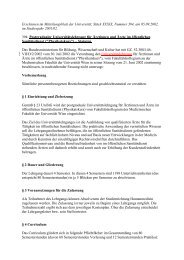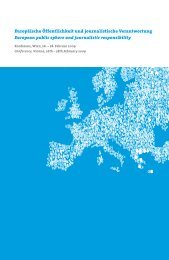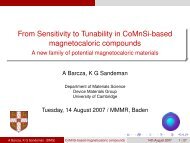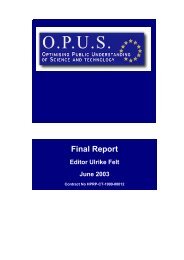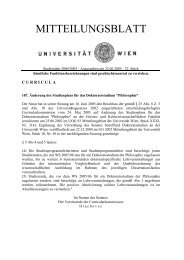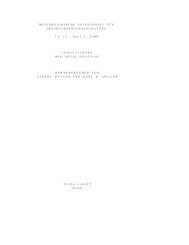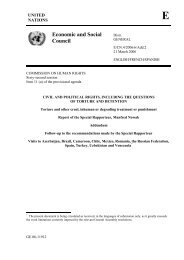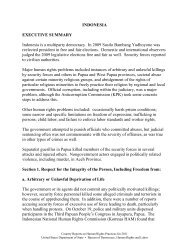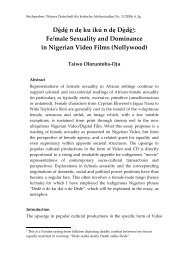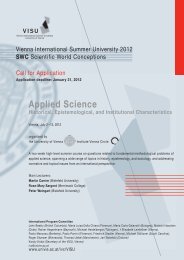(Stand: 25. Juli 2007) ANDERSON, Michael Alan ... - Universität Wien
(Stand: 25. Juli 2007) ANDERSON, Michael Alan ... - Universität Wien
(Stand: 25. Juli 2007) ANDERSON, Michael Alan ... - Universität Wien
Create successful ePaper yourself
Turn your PDF publications into a flip-book with our unique Google optimized e-Paper software.
MEDIEVAL & RENAISSANCE MUSIC CONFERENCE <strong>2007</strong> – WIEN, 7.-11. AUGUST ABSTRACTS<br />
Kantionale“ (<strong>Universität</strong>sbibliothek Augsburg, Cod. III. 1. 8° 57 (olim K 284)) eine<br />
reichhaltige Liedersammlung, die von beliebten Sequenzen über Benedicamus-Domino-<br />
Gesängen, die auf den örtlichen Gebrauch abgestimmt sind, bis hin zu Oster- und<br />
Weihnachts-„Klassikern“ wie Surrexit Christus hodie / Erstanden ist der haylig christ, Dies est<br />
laeticie/Der tag der ist so freyderych und In dulci jubilo reicht. Dies deutet darauf hin, daß<br />
auch in Kirchheim die für Nonnenklöster typischen Bräuche des Osterspiels und des<br />
Kindelwiegens in der ersten Hälfte des 16. Jahrhunderts gepflegt wurden. Der Vergleich<br />
mit weiteren Liederhandschriften süddeutscher Provenienz fordert dazu heraus, diese<br />
Quellen auf geschlechtsspezifische Musizierformen zu untersuchen. Doch die zweite<br />
Schreiberin, Agnes Bühlerin, begnügt sich nicht damit, bewährtes Material aufzuzeichnen,<br />
sondern geht mit den überlieferten Texten (Melodien sind nur für die liturgischen<br />
Stücke notiert) kreativ, wenn auch mit wechselndem dichterischen Erfolg um. Mit<br />
Humor thematisiert sie ihre Rolle als Bearbeiterin von geistlichen Versatzstücken und<br />
hinterläßt in ihrem Liederbuch die Spuren einer eigenwilligen, musikbegeisterten Persönlichkeit.<br />
EISENBERG, <strong>Michael</strong><br />
� �<br />
Anonymous Intention in Il Divino’s Intabolatura da leuto, Bibliotheca Musica<br />
Bononiensis, IV/89<br />
Mittwoch/Wednesday, 8.8., 9.45 Uhr, KuGe, SR 1<br />
As the earliest extant copper-engraved music, the undated Intabolatura da leuto del divino<br />
Francesco da Milano (Bologna?, ca. 1535/6) stands as one of the crown treasures of the<br />
Österreichische Nationalbibliothek. Its florid captions and fluidity of line lend prestige to<br />
this elegant exemplar, so way ahead of its time. No location or publisher’s name appears<br />
on the frontispiece. However, since Francesco Marcolini’s contemporaneous lute<br />
anthology Intabolatura di liuto di diversi also might be engraved and since he played an<br />
active role in the publication of da Milano’s tablature it has been speculated that he is the<br />
unnamed publisher in question. Yet, Marcolini’s Venetian privilege of the same year<br />
expressly stipulated the exemption of its legal application to engraved editions. Pavan insinuates<br />
that engraving might have offered a loophole for printing tablature. This resonates<br />
sympathetically with the parallel 17 th -century French legal precedent whereby<br />
engraving offered a lucrative alternative to combat the monopoly wielded by the Ballard<br />
firm, whose patent on music printing had hitherto effectively eschewed all competition. It<br />
is certainly worth considering how, in addition to furnishing a more expressive mode to<br />
document the elusive art of improvisatio, engraving might also have provided a viable route<br />
around privilege protection and censorship.<br />
In the papal courtly orbit from 1514, Francesco was more prolific in print than any<br />
other contemporary lutenist. With this high profile, the composer was constantly subjected<br />
to the editorial vagaries of typography as attested in the inaccuracies of his recercares<br />
published by Attaingnant in 1529. In 1536, the likely date of the Vienna exemplar,<br />
Milano exploded onto the printing scene with an impressive array of five discrete editions,<br />
issued in Milan, Naples, and Venice. Yet in comparison with the cruder movabletype<br />
transmissions, the technology of copper engraving allowed much greater precision<br />
and subtlety in notational detail. Was Milano involved in the selection of this flexible<br />
- 30 -




